Are you fascinated by the vibrant energy and captivating movements of the chicken dance, also known as fancy dance? On ten-dance.com, we’ll explore the art of crafting a chicken dance bustle, a crucial element of the regalia, with step-by-step guidance suitable for all skill levels. From feather selection to intricate construction techniques, discover how to create a stunning bustle that embodies the spirit and tradition of this exhilarating dance style. We also share the knowledge and information you can use for Native American dance culture, traditional dance, and pow wow dancing.
1. What Is A Chicken Dance Bustle?
A chicken dance bustle is a vibrant and eye-catching component of the regalia worn by fancy dancers at powwows. It consists of a circular or semi-circular frame adorned with brightly colored feathers that create a dazzling display of movement during the dance.
1.1 What Is The Significance Of The Chicken Dance Bustle?
The chicken dance bustle is significant for its visual representation of the dancer’s energy and connection to tradition. The feathers symbolize birds, and the dancer’s movements mimic those of a chicken, displaying agility and grace.
1.2 What Are The Different Types Of Feathers Used In Chicken Dance Bustles?
Various feathers, including those from turkeys, pheasants, and peacocks, are commonly used in chicken dance bustles. The choice of feathers often depends on their color, texture, and availability, allowing dancers to create unique and personalized bustles.
1.3 How Does The Chicken Dance Bustle Enhance The Performance Of The Dancer?
The chicken dance bustle enhances the dancer’s performance by adding visual flair and emphasizing their movements. The feathers sway and ripple with each step, creating a mesmerizing spectacle that captivates the audience and adds to the overall excitement of the dance.
2. Gathering Your Materials
Before you begin creating your chicken dance bustle, gather all the necessary materials. This will ensure a smooth and efficient crafting process.
2.1 What Types Of Feathers Should I Use For My Chicken Dance Bustle?
The types of feathers you should use for your chicken dance bustle are vibrant and lightweight feathers, such as turkey, pheasant, or peacock feathers. These feathers add color and movement to your bustle.
2.2 Where Can I Source High-Quality Feathers For My Bustle?
High-quality feathers for your bustle can be sourced from reputable craft stores, online retailers specializing in Native American craft supplies, or local powwows where vendors often sell feathers and other regalia materials. Ensure the feathers are clean, undamaged, and ethically sourced.
2.3 What Other Materials Do I Need Besides Feathers?
Besides feathers, you will need a sturdy frame (usually made of wire or wood), strong thread or sinew, beads, leather or fabric for embellishments, scissors, pliers, and a hot glue gun. These materials will help you assemble and decorate your chicken dance bustle.
2.4 How Much Will The Materials Cost To Make A Chicken Dance Bustle?
The cost of materials to make a chicken dance bustle can vary widely, depending on the type and quantity of feathers, the quality of the frame, and the embellishments you choose. A basic bustle can cost between $50 and $150, while more elaborate designs can cost several hundred dollars.
3. Constructing The Bustle Frame
The frame provides the structure and shape for your chicken dance bustle. Choose a sturdy material that can withstand the movements of the dance.
3.1 What Materials Are Best For Making The Bustle Frame?
The best materials for making a bustle frame are sturdy yet lightweight options such as wire, wood, or plastic hoops. Wire is flexible and easy to shape, wood provides a traditional look and feel, and plastic hoops offer durability and weather resistance.
3.2 How Do I Shape The Frame Into The Desired Circular Or Semi-Circular Form?
Shape the frame into the desired circular or semi-circular form using pliers (for wire), bending tools (for wood), or by molding the plastic hoop. Ensure the shape is symmetrical and comfortable to wear.
3.3 How Do I Ensure The Frame Is Strong And Durable Enough To Withstand The Dance Movements?
To ensure the frame is strong and durable, reinforce joints with glue or wire, use multiple layers of material, and test the frame’s strength by applying pressure and simulating dance movements.
3.4 Can I Use Pre-Made Hoops Or Frames For My Bustle?
Yes, pre-made hoops or frames can be used for your bustle. These are available at craft stores and online retailers and can save time and effort in the construction process.
4. Preparing The Feathers
Preparing the feathers is a crucial step in creating a visually stunning chicken dance bustle. Proper preparation ensures that the feathers are clean, vibrant, and ready to be attached to the frame.
4.1 How Do I Clean And Prepare The Feathers For Attachment?
To clean and prepare the feathers for attachment, gently wash them with mild soap and water, rinse thoroughly, and allow them to air dry. Once dry, trim any excess quill or damaged barbs to ensure a clean and uniform appearance.
4.2 Should I Dye Or Paint The Feathers To Achieve The Desired Colors?
Yes, you can dye or paint the feathers to achieve the desired colors. Use fabric dye or acrylic paint specifically designed for feathers, and follow the manufacturer’s instructions carefully. Ensure the dye or paint is evenly distributed for a consistent and vibrant color.
4.3 How Do I Arrange The Feathers To Create A Visually Appealing Design?
Arrange the feathers to create a visually appealing design by laying them out on a flat surface and experimenting with different patterns and color combinations. Consider the overall symmetry, balance, and flow of the design to achieve a dynamic and eye-catching effect.
4.4 How Do I Protect The Feathers From Damage During The Bustle-Making Process?
Protect the feathers from damage during the bustle-making process by handling them carefully, storing them in a safe place when not in use, and using gentle adhesives or stitching techniques to attach them to the frame. Avoid excessive bending or crushing of the feathers to maintain their shape and integrity.
5. Attaching The Feathers To The Frame
Attaching the feathers to the frame is where your vision for the chicken dance bustle starts to take shape. Secure and artful attachment will ensure a beautiful and durable final product.
5.1 What Is The Best Method For Attaching Feathers To The Frame?
The best method for attaching feathers to the frame is using a combination of strong thread or sinew and a hot glue gun. This ensures a secure and long-lasting hold while allowing for flexibility in design.
5.2 How Do I Ensure The Feathers Are Securely Attached And Won’t Fall Off During Dancing?
To ensure the feathers are securely attached and won’t fall off during dancing, use a generous amount of glue, wrap the thread tightly around the quill and frame, and consider adding a second layer of glue for extra reinforcement.
5.3 What Patterns Or Techniques Can I Use To Create A Dynamic And Visually Interesting Arrangement?
Create a dynamic and visually interesting arrangement by experimenting with different feather lengths, colors, and angles. Overlapping feathers, creating layered effects, and incorporating beads or other embellishments can add depth and texture to your design.
5.4 How Do I Maintain Symmetry And Balance In The Bustle Design?
Maintain symmetry and balance in the bustle design by working on both sides of the frame simultaneously and regularly stepping back to assess the overall appearance. Use a ruler or measuring tape to ensure feathers are evenly spaced and aligned.
6. Adding Embellishments And Details
Embellishments and details add a personal touch to your chicken dance bustle, enhancing its visual appeal and reflecting your individual style.
6.1 What Types Of Embellishments Can I Add To My Chicken Dance Bustle?
You can add beads, ribbons, leather fringe, sequins, and other decorative elements to your chicken dance bustle. These embellishments add texture, color, and sparkle to the design.
6.2 How Do I Attach Beads, Sequins, Or Other Decorative Elements?
Attach beads, sequins, or other decorative elements by sewing them onto the feathers or frame using strong thread or by gluing them in place with a hot glue gun. Ensure the embellishments are securely attached and won’t come loose during dancing.
6.3 Can I Incorporate Cultural Or Tribal Symbols Into My Bustle Design?
Yes, you can incorporate cultural or tribal symbols into your bustle design. This can be done by using specific colors, patterns, or motifs that represent your heritage or community.
6.4 How Do I Personalize My Bustle To Reflect My Individual Style And Preferences?
Personalize your bustle to reflect your individual style and preferences by choosing colors, embellishments, and patterns that resonate with you. Consider incorporating elements that are meaningful to you, such as family symbols, favorite animals, or personal totems.
7. Finishing Touches And Maintenance
The final touches and proper maintenance will ensure your chicken dance bustle looks its best and lasts for many performances to come.
7.1 How Do I Secure The Bustle To My Dance Outfit?
Secure the bustle to your dance outfit using sturdy straps, ties, or clips that attach to your belt or other clothing. Ensure the bustle is securely fastened and won’t shift or come loose during dancing.
7.2 How Should I Store And Transport My Bustle To Prevent Damage?
Store and transport your bustle in a protective case or bag to prevent damage from dust, moisture, or impact. Consider wrapping the bustle in soft cloth or bubble wrap for added protection.
7.3 How Do I Clean And Maintain My Bustle To Keep It Looking Its Best?
Clean and maintain your bustle by gently dusting it with a soft brush or cloth to remove dirt and debris. Avoid exposing the bustle to excessive moisture or sunlight, and repair any loose feathers or embellishments promptly.
7.4 What Are Some Common Repairs Or Adjustments I Might Need To Make Over Time?
Common repairs or adjustments you might need to make over time include replacing loose feathers, reattaching embellishments, tightening straps or ties, and reinforcing the frame. Regular inspection and maintenance will help prolong the life of your chicken dance bustle.
8. Honoring The Tradition
Creating and wearing a chicken dance bustle is not just about crafting an eye-catching accessory; it’s about honoring a rich cultural tradition and respecting the significance of the dance.
8.1 What Is The Cultural Significance Of The Chicken Dance And Its Regalia?
The cultural significance of the chicken dance and its regalia lies in its representation of agility, grace, and connection to nature. The dance mimics the movements of a chicken, symbolizing respect for animals and the natural world.
8.2 How Can I Ensure I Am Creating And Wearing My Bustle In A Respectful And Culturally Appropriate Manner?
Ensure you are creating and wearing your bustle in a respectful and culturally appropriate manner by learning about the history and significance of the dance from knowledgeable sources, seeking guidance from elders or experienced dancers, and avoiding any actions that could be seen as disrespectful or appropriative.
8.3 What Are Some Resources For Learning More About The History And Significance Of The Chicken Dance?
Some resources for learning more about the history and significance of the chicken dance include books, articles, documentaries, and websites dedicated to Native American culture and dance. You can also attend powwows, workshops, and cultural events to learn from experienced dancers and cultural experts.
8.4 How Can I Support And Promote The Preservation Of Native American Culture And Traditions?
Support and promote the preservation of Native American culture and traditions by educating yourself and others about Native American history and issues, supporting Native American artists and businesses, advocating for Native American rights and sovereignty, and respecting and honoring Native American cultural practices.
9. Finding Inspiration And Community
Connecting with other dancers and enthusiasts can provide inspiration, support, and opportunities for learning and growth.
9.1 Where Can I Find Inspiration For My Bustle Design?
You can find inspiration for your bustle design by attending powwows, browsing online galleries and social media groups dedicated to Native American dance regalia, and studying the work of experienced bustle makers.
9.2 Are There Online Communities Or Forums Where I Can Connect With Other Bustle Makers And Dancers?
Yes, there are online communities and forums where you can connect with other bustle makers and dancers. Websites like ten-dance.com offer forums and communities for dance enthusiasts to connect, share ideas, and learn from each other.
9.3 Can I Attend Workshops Or Classes To Learn More About Bustle Making And Dance?
Yes, you can attend workshops or classes to learn more about bustle making and dance. These workshops are often offered at powwows, cultural centers, and Native American community organizations.
9.4 How Can I Get Involved In My Local Native American Community?
Get involved in your local Native American community by attending cultural events, volunteering your time, supporting local organizations, and building relationships with community members.
10. Advanced Techniques And Customization
Once you’ve mastered the basics of bustle making, you can explore advanced techniques and customization options to create truly unique and stunning pieces.
10.1 How Can I Incorporate Advanced Techniques Like Layering, Shading, Or 3D Elements Into My Bustle Design?
Incorporate advanced techniques like layering, shading, or 3D elements into your bustle design by experimenting with different feather textures, colors, and arrangements. You can also use foam or other materials to create raised or sculpted elements that add depth and dimension to your design.
10.2 What Are Some Innovative Materials Or Techniques I Can Use To Make My Bustle Stand Out?
Some innovative materials or techniques you can use to make your bustle stand out include using LED lights, incorporating reflective materials, creating kinetic elements that move with the dancer, and using unconventional feathers or embellishments.
10.3 How Can I Create A Bustle That Is Specifically Tailored To My Dance Style And Movements?
Create a bustle tailored to your dance style and movements by considering the size, shape, and weight of the bustle, as well as the way it moves with your body. Experiment with different designs and materials to find what works best for you and enhances your performance.
10.4 How Can I Document And Share My Bustle-Making Process With Others?
Document and share your bustle-making process with others by taking photos or videos of each step, writing detailed instructions, and sharing your work on social media, online forums, or personal websites. This can inspire others and help preserve traditional knowledge.
FAQ: Making a Chicken Dance Bustle
Here are some frequently asked questions about making a chicken dance bustle:
1. What Is The Difference Between A Chicken Dance Bustle And A Traditional Bustle?
A chicken dance bustle is usually more colorful and flamboyant, using bright, commercially dyed feathers, while a traditional bustle often uses feathers from birds of prey and other natural materials. The chicken dance bustle is designed for showmanship and fast movements.
2. How Long Does It Take To Make A Chicken Dance Bustle?
The time it takes to make a chicken dance bustle varies depending on the complexity of the design and your skill level. A simple bustle may take a few days, while a more elaborate one could take weeks or months.
3. Can I Make A Chicken Dance Bustle If I’m Not Native American?
If you are not Native American, it’s best to avoid making or wearing regalia unless you have been given permission or guidance by a Native American community. Regalia often has deep cultural and spiritual significance.
4. What Is The Best Way To Store A Chicken Dance Bustle?
The best way to store a chicken dance bustle is in a cool, dry place, away from direct sunlight. Use a garment bag or a protective case to prevent dust and damage to the feathers.
5. How Much Does A Chicken Dance Bustle Cost To Buy?
The cost of a chicken dance bustle can range from a few hundred dollars to several thousand, depending on the materials used, the complexity of the design, and the artist’s reputation.
6. What Type Of Frame Is Best For A Chicken Dance Bustle?
A lightweight, durable frame made of wire or wood is best for a chicken dance bustle. The frame should be strong enough to support the feathers but light enough to allow for easy movement during the dance.
7. How Do I Clean My Chicken Dance Bustle?
To clean your chicken dance bustle, gently dust it with a soft brush or cloth. Avoid using water or harsh chemicals, as these can damage the feathers.
8. What Kind Of Glue Should I Use For Attaching Feathers?
Use a hot glue gun or a strong adhesive specifically designed for feathers. Ensure the glue is flexible and won’t damage the feathers.
9. How Do I Choose The Right Size Bustle For My Body?
Choose a bustle that is proportional to your body size and allows for freedom of movement. The bustle should not be too large or heavy, as this can impede your dancing.
10. Can I Customize My Chicken Dance Bustle With LED Lights?
Yes, you can customize your chicken dance bustle with LED lights for a unique and eye-catching effect. Be sure to use battery-powered lights and secure them safely to the frame.
Creating a chicken dance bustle is a rewarding experience that combines creativity, skill, and cultural appreciation. By following these steps and honoring the tradition, you can craft a stunning piece of regalia that reflects your individual style and celebrates the vibrant spirit of the chicken dance.
Ready to start your dance journey? Visit ten-dance.com today and discover a wealth of resources, from online lessons to local dance classes and vibrant community forums. Don’t miss out on the latest dance events and workshops happening near you! Join ten-dance.com now and let your passion for dance soar. You can visit us at 60 Lincoln Center Plaza, New York, NY 10023, United States or call us at +1 (212) 769-7000.
Alt: Matthew Gives Plenty, a Rosebud Sioux tribal member, poses for a portrait in traditional attire.
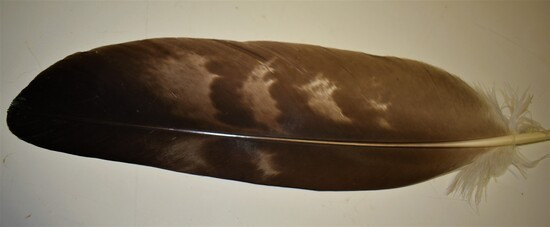 MattAlt: Close-up of Matt holding a feather, highlighting its intricate structure and details.
MattAlt: Close-up of Matt holding a feather, highlighting its intricate structure and details.
 Feather undersideAlt: Underside of a feather showing the detailed quill structure, emphasizing its natural design.
Feather undersideAlt: Underside of a feather showing the detailed quill structure, emphasizing its natural design.
 Zoomed feather undersideAlt: Zoomed view of a feather’s underside, revealing the delicate arrangement of quills for air-tight bonding.
Zoomed feather undersideAlt: Zoomed view of a feather’s underside, revealing the delicate arrangement of quills for air-tight bonding.
 Matt 1979Alt: Matthew Gives Plenty in 1979, captured in a candid shot showcasing his traditional attire.
Matt 1979Alt: Matthew Gives Plenty in 1979, captured in a candid shot showcasing his traditional attire.
 Cedar Feather BoxesAlt: Two cedar feather boxes, prizes won while pow wow dancing, used for safely storing loose feathers.
Cedar Feather BoxesAlt: Two cedar feather boxes, prizes won while pow wow dancing, used for safely storing loose feathers.
 Abbreviated version of a Traditional Dance bustle.Alt: Abbreviated version of a traditional dance bustle designed to fit a middle-sized child.
Abbreviated version of a Traditional Dance bustle.Alt: Abbreviated version of a traditional dance bustle designed to fit a middle-sized child.
 Fancy (chicken) Dance bustle made for my oldest son. One of two matching, worn one above the other. The bottom one is worn at belt level, the other placed between the shoulders high on the back.Alt: Fancy chicken dance bustle, one of two matching sets worn by an oldest son, one at belt level and another high on the back.
Fancy (chicken) Dance bustle made for my oldest son. One of two matching, worn one above the other. The bottom one is worn at belt level, the other placed between the shoulders high on the back.Alt: Fancy chicken dance bustle, one of two matching sets worn by an oldest son, one at belt level and another high on the back.
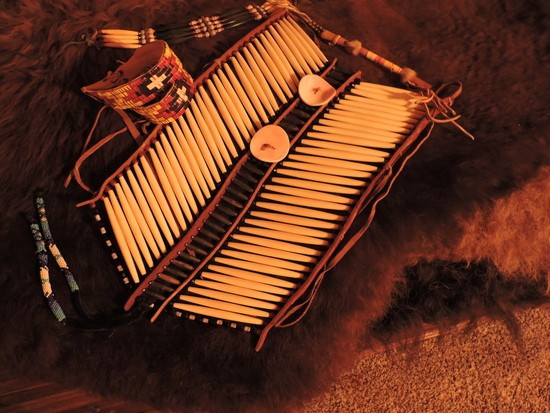 Dance regaliaAlt: Dance regalia including quilled armbands, a bone whistle, and a breastplate made of strung hair pipes, showcasing traditional attire elements.
Dance regaliaAlt: Dance regalia including quilled armbands, a bone whistle, and a breastplate made of strung hair pipes, showcasing traditional attire elements.
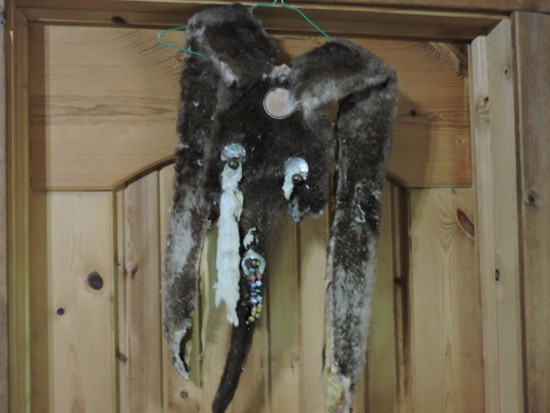 Backside of otter capeAlt: Backside view of an otter cape, focusing on the central part that hangs down the dancer’s back.
Backside of otter capeAlt: Backside view of an otter cape, focusing on the central part that hangs down the dancer’s back.
 Otter cape/breastplate dropsAlt: Mirrored drops hanging frontside of an otter cape, bordering each edge of a hair pipe breastplate.
Otter cape/breastplate dropsAlt: Mirrored drops hanging frontside of an otter cape, bordering each edge of a hair pipe breastplate.
 Sungleshka supplanted Sho as my youngest son.Alt: Sungleshka, in his cradleboard, replaces Sho as the youngest son in a family portrait.
Sungleshka supplanted Sho as my youngest son.Alt: Sungleshka, in his cradleboard, replaces Sho as the youngest son in a family portrait.
 Our Pow Wow rig, which includes a rack for hauling the 28Alt: Our pow wow rig includes a rack for hauling 28’ long tipi poles, ready for travel.
Our Pow Wow rig, which includes a rack for hauling the 28Alt: Our pow wow rig includes a rack for hauling 28’ long tipi poles, ready for travel.
 Inside our tipi. You are looking at the rear center space at back area opposite the door. Everything placed to be easy to get dressed and ready to dance.Alt: Inside a tipi, looking at the rear center space, with dance outfits and Matt’s bustle hanging from the liner.
Inside our tipi. You are looking at the rear center space at back area opposite the door. Everything placed to be easy to get dressed and ready to dance.Alt: Inside a tipi, looking at the rear center space, with dance outfits and Matt’s bustle hanging from the liner.
 Delivering the tribal flag. Yankton 1982.Alt: Horseback riders delivering the tribal flag, Yankton, 1982, during a ceremonial event.
Delivering the tribal flag. Yankton 1982.Alt: Horseback riders delivering the tribal flag, Yankton, 1982, during a ceremonial event.
 Host drum arriving on flatbed trailer.Alt: The host drum arrives on a flatbed trailer with the dance arena in the background.
Host drum arriving on flatbed trailer.Alt: The host drum arrives on a flatbed trailer with the dance arena in the background.
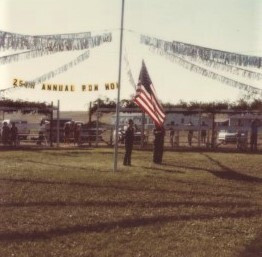 Raising MattAlt: Raising Matt’s flag high on a pole, honoring his memory at the pow wow.
Raising MattAlt: Raising Matt’s flag high on a pole, honoring his memory at the pow wow.
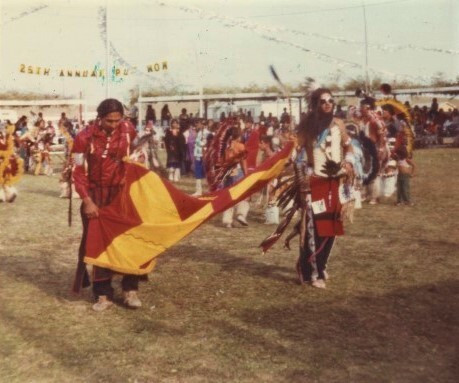 It was a great honor for me to join Mitch Walking Elk (left) dancing in the Tribal flag.Alt: The narrator and Mitch Walking Elk dance with the Tribal flag, symbolizing respect and honor at the pow wow.
It was a great honor for me to join Mitch Walking Elk (left) dancing in the Tribal flag.Alt: The narrator and Mitch Walking Elk dance with the Tribal flag, symbolizing respect and honor at the pow wow.
 An elder Traditional DancerAlt: An elder traditional dancer participates in the pow wow, displaying cultural pride.
An elder Traditional DancerAlt: An elder traditional dancer participates in the pow wow, displaying cultural pride.
 My friend Rick is a Traditional Dancer from Pine Ridge.Alt: Rick, a traditional dancer from Pine Ridge, showcasing his regalia at the pow wow.
My friend Rick is a Traditional Dancer from Pine Ridge.Alt: Rick, a traditional dancer from Pine Ridge, showcasing his regalia at the pow wow.
 Closer look of Rick.Alt: A closer view of Rick dancing, highlighting the intricate details of his traditional attire.
Closer look of Rick.Alt: A closer view of Rick dancing, highlighting the intricate details of his traditional attire.
 RickAlt: Rick’s brother, also a traditional dancer, dances at the Lake Andes pow wow.
RickAlt: Rick’s brother, also a traditional dancer, dances at the Lake Andes pow wow.
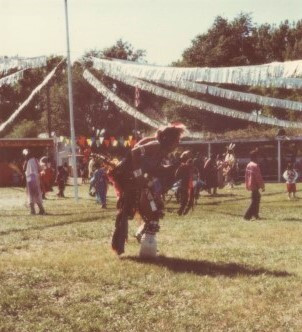 Our elder getting into it.Alt: An enthusiastic elder fully engaged in the drumming and rhythm of the pow wow.
Our elder getting into it.Alt: An enthusiastic elder fully engaged in the drumming and rhythm of the pow wow.
 Dancing at Lake Andes.Alt: A vibrant scene of dancers at Lake Andes, captured nearly 40 years ago, showcasing the energy of the pow wow.
Dancing at Lake Andes.Alt: A vibrant scene of dancers at Lake Andes, captured nearly 40 years ago, showcasing the energy of the pow wow.
 Traditional Dancer 1982 Lake AndesAlt: Traditional dancer, Lake Andes 1982, close-up view of a traditional dance bustle; no two are the same.
Traditional Dancer 1982 Lake AndesAlt: Traditional dancer, Lake Andes 1982, close-up view of a traditional dance bustle; no two are the same.
 Name Transfer Ceremony.Alt: Name transfer ceremony with family gathered, blankets ready to be gifted, honoring cultural heritage.
Name Transfer Ceremony.Alt: Name transfer ceremony with family gathered, blankets ready to be gifted, honoring cultural heritage.
 A Woman Traditional dancer resting during the afternoon session. She watched over our youngest while we were doing the ceremony.Alt: A traditional woman dancer resting during the afternoon session watched over the youngest during the ceremony.
A Woman Traditional dancer resting during the afternoon session. She watched over our youngest while we were doing the ceremony.Alt: A traditional woman dancer resting during the afternoon session watched over the youngest during the ceremony.
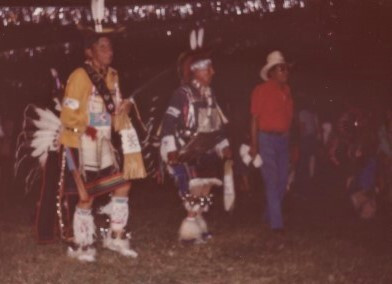 Night sessionAlt: Night session action at the Lake Andes pow wow; Uncle Ben can’t stay off the dance ground.
Night sessionAlt: Night session action at the Lake Andes pow wow; Uncle Ben can’t stay off the dance ground.
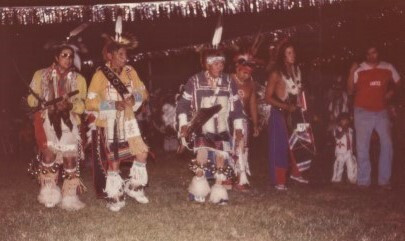 Night session 1982 Lake AndesAlt: Night session 1982, Lake Andes; Cuz Ben Jr dances in blue leggings, a very handsome young man and fine dancer.
Night session 1982 Lake AndesAlt: Night session 1982, Lake Andes; Cuz Ben Jr dances in blue leggings, a very handsome young man and fine dancer.
 Night session Lake Andes 1982Alt: Night session at Lake Andes 1982, showcasing blue leggings worn during the dance.
Night session Lake Andes 1982Alt: Night session at Lake Andes 1982, showcasing blue leggings worn during the dance.
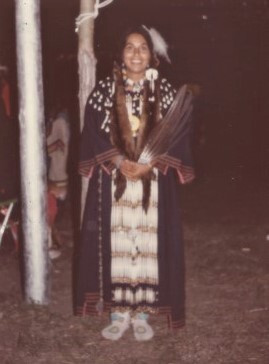 Night session 1982Alt: Night session, a beautiful lady’s invitation to partner for a Two-Step Dance has never been turned down.
Night session 1982Alt: Night session, a beautiful lady’s invitation to partner for a Two-Step Dance has never been turned down.
 My Quapaw friend who came all the way up to S.D. in honor of Matt. He is an artist who provided some drawings for one of my books. Note the different style displayed by his attire compared to what our more northern prairie style is like.Alt: Quapaw friend came to S.D. for Matt, an artist, with attire different from the northern prairie style.
My Quapaw friend who came all the way up to S.D. in honor of Matt. He is an artist who provided some drawings for one of my books. Note the different style displayed by his attire compared to what our more northern prairie style is like.Alt: Quapaw friend came to S.D. for Matt, an artist, with attire different from the northern prairie style.
 Saturday night session. Uncle Ben back at it again!Alt: Saturday night session; Uncle Ben back at it again on the dance ground.
Saturday night session. Uncle Ben back at it again!Alt: Saturday night session; Uncle Ben back at it again on the dance ground.
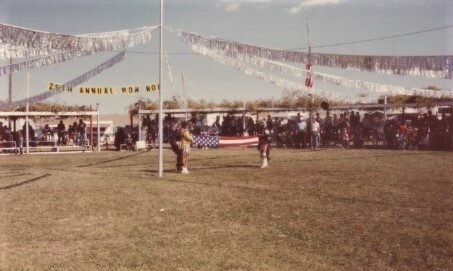 Closing ceremonies. MattAlt: Closing ceremonies; Matt’s flag is lowered and properly folded for safe keeping.
Closing ceremonies. MattAlt: Closing ceremonies; Matt’s flag is lowered and properly folded for safe keeping.

